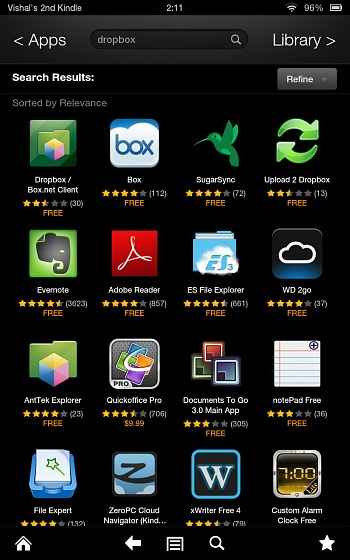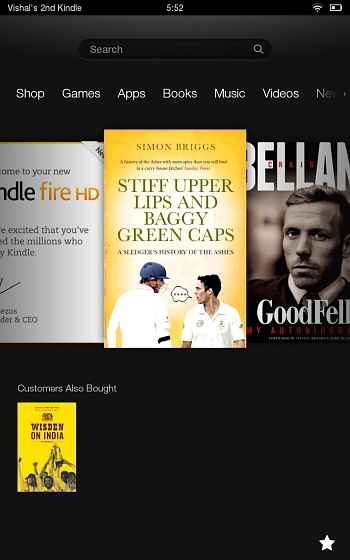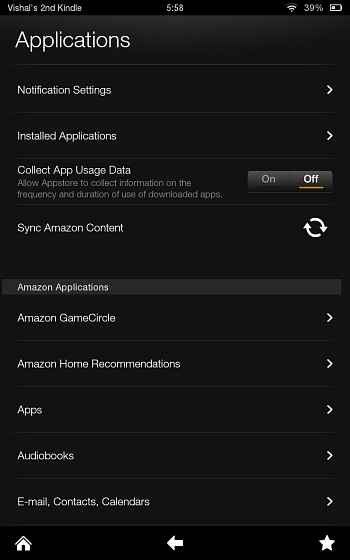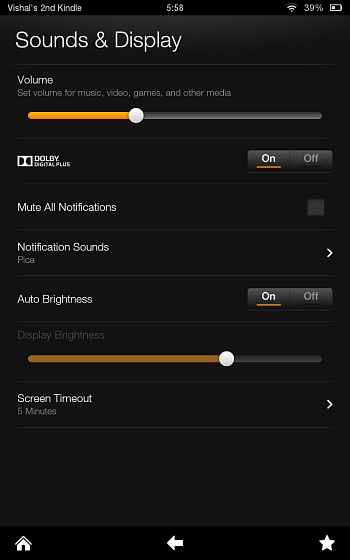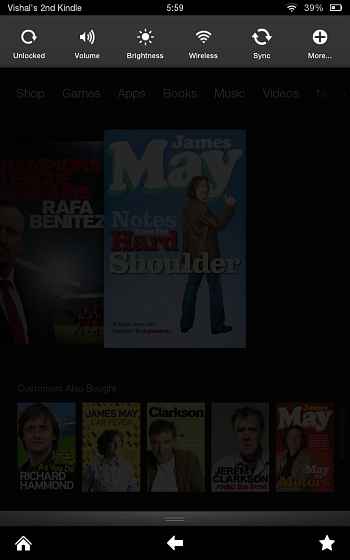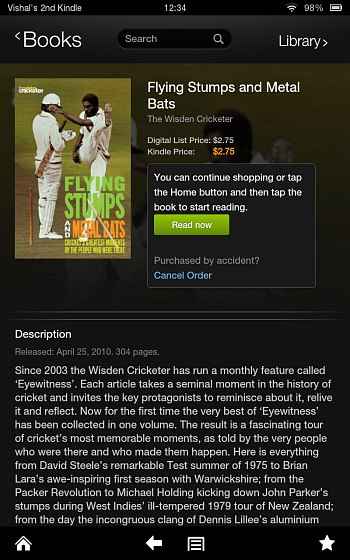Before anyone gets confused and starts comparing this with the likes of the Google Nexus 7 and the other Android tablets out there, it is imperative to specify that this tablet is made to work in the Amazon ecosystem. While it may be Android at the very basic level, the Amazon skin completely takes over. Excellent hardware and display make this a very good device to read text on, and the gaming performance is impressive. Buy this, if you want to invest in the Amazon ecosystem of books and apps, because there is no access to Google's Play store.
Kindle Fire: Introducing the device
There are two aspects to this introduction. First, yes, this is technically an Android device, but only to the very foundation of the software. Beyond that, Amazon has wrapped its skin so tightly around the actual OS that many users may not even realize it is an Android device. It is not like any Android tablet you may have seen or used, and doesn’t work any of them either. And yes, since it does carry the Kindle branding, it does let you read books, not to worry! Just that the e-ink display has been done away in favor of a more tablet-friendly HD IPS display.
Now that we have clarified what the Kindle Fire HD is all about, we take a look at how the product feels, performs and whether it is worth your money.
Build / Design: Industrial, without being rough
We have the review unit for the 7-inch version of the Kindle Fire HD. Yes, there is a bigger 8.9-inch version available as well, in case that is more relevant for you. Straight out-of-the-box, and the industrial build and the clean design catch your attention immediately. The 7-inch display is framed by a rather thick bezel, with the front-facing camera placed there, but it doesn’t gather too much attention. Unlike the iPad Mini though, the thick bezel does ensure that the Kindle Fire HD with the 7-inch display does have a rather big footprint.
One of the things about this 7-inch version is the lightness aspect. Yes, on paper, at 395 grams it is a lot more than the 308 grams the Apple iPad Mini (albeit with a slightly bigger display) weighs, but do remember, at almost 350 grams, the Google Nexus 7 was praised for being “extremely light”. Also, the BlackBerry PlayBook weighs well upwards of 420 grams.
The weight debate aside, the Kindle Fire HD is built very well. It is clear that Amazon isn’t cutting any corners in terms of how the product is put together, the materials used and the experience of holding and using it. The rear panel has a dual-tone finish. The majority part of this panel has the soft touch black colour finish, which is a boon as it largely keeps the device free from the risk of scratches. Somewhere along the middle runs a strip with a typical shiny plastic finish. This is where the Kindle branding is done, and also houses the dual speakers on either end. The design and implementation of these speaker grilles is quite neat, but they do tend to confuse when you are searching for the volume rocker or the power key, but not looking down at the device.
There is no slot for memory expansion on the Kindle Fire HD 7, and the ports and hardware keys are spread across the side spines. The idea seems clear – keep the area around the display clean, so that there are no distractions when the user is immersed in the content. One side spine features the micro USB port for charging or data transfer to and from a PC, along with a mini HDMI port for connecting to a bigger display unit, like an HDTV.
This is where it is important to note that most tablet manufacturers, including Amazon, is not providing the full bunch of cables with the device. If memory serves us correctly, BlackBerry provided the HDMI cable with the PlayBook. Maybe something for Amazon and the other tablet makers to ponder on.
Coming back to the issue of population of the spines, one of the smaller side spines (top or bottom – if you are holding the Kindle in the portrait mode) has the power key and the volume rocker. The basic idea behind the design of these keys clearly is to blend them in well with the rest of the slightly curved spines. While there is nothing wrong with how they work and respond, but the problem lies with how flush they are with the rest of the body. Unless you specifically search for them, the fingers will most likely not find them easily.
Clearly, the Kindle Fire HD 7 is a very well built device. The materials used are high quality, and the device feels solid and to a certain extent, rugged, when held. In comparison, the Google Nexus 7 just feels much inferior, with all due respects to all fans.
Setup: Not much to do!
Amazon, very neatly, pre-registers your Amazon account with the device before shipping it to you. The result is simple – you get the device, you switch it on, connect it to Wi-Fi and all your purchased content shows up in the blink of an eye. The good thing is, it doesn’t automatically start downloading. For example, the books will all immediately show up under the Cloud tab, and you can long tap on each book cover to download.
The only downside of this is that you cannot really reset the device and switch users randomly, because then content is lost and your cloud sync ID is disturbed.
Display: Very impressive
Amazon has packed in a lot into the Kindle Fire HD. What you notice immediately, and will use the most often (obviously, duh!) is the 7-inch display. We really like what this IPS LCD display throws up. The resolution of 1280 x 800 pixels is more than what the Apple iPad Mini has to show for its display, and at par with the likes of the Nexus 7 and the Playbook. But, more than sheer numbers, it is the quality of reproduction of the content which is impressive. Being an IPS display, this one does very well in terms of colour reproduction. Amazon has done some tweaks to the display package, and that has made a lot of difference.
First change, they claim, helps with reducing glare off the screen. According to Amazon, they have brought the LCD and the touch sensor layer together on one layer of glass. That is a piece of info for the pedantic demographic, but in real life, the reflections off the screen and eventually the viewing angles are a couple of steps ahead of the Apple iPad Mini, very evident in a side by side comparison. And this is very much welcome when you may be reading an e-book sitting outdoors, where distractions off any screen not only annoy, but also lead to eye strain. In a simple real world test, we tried reading a book in the evening sunlight outside in the balcony, and while the Kindle’s brightness was set at 20%, the iPad Mini’s brightness had to be bumped up to around 30% to read the same book. Marginal difference in terms of brightness levels, but a huge difference in real world comfort.
All in all, we would peg the Kindle Fire HD’s display on a higher pedestal than that of the Apple iPad Mini. The Kindle has a distinct advantage in text rendering, crispness and readability over the iPad Mini. Understandable, given that the higher resolution on the Kindle ensures text doesn’t look pixilated. Very critical, since you may actually spend a lot of time reading through your Amazon e-book library. However, the iPad Mini is pretty much at par in terms of video playback – clarity, handling the fast motion scenes and the black levels. Don’t be fooled by the slightly grey Amazon UI’s interface colour! But, For viewing photographs, the better colour richness offered by the IPS on the Kindle gives it a small advantage over the iPad Mini.
Connectivity: Very basic
The Kindle Fire HD clearly doesn’t have any aspirations to show off a gamut of connectivity options, mostly the kind that consumers do not often use. But among them, Amazon kind of overlooked a couple that people use. For starters, the Kindle Fire HD has Wi-Fi connectivity, but no 3G capability. Admittedly, this is a bit limiting. If you want people to be locked to your ecosystem, there should in fact be a craving to give them access to the services and apps at all times. Wouldn't that earn more money? However, the device does get dual Wi-Fi antennas and MIMO technology to help with connectivity when you are really testing the outer limits of the poor Wi-Fi router’s range.
There is no GPS on the Kindle Fire HD 7, and that is again a rather glaring omission. Though it is not paralyzing or critical, it is sad the Nexus 7 can set you on your way with Google Maps or whatever, and disappointing that the Fire HD cannot. For the fact lovers, even the Apple iPad Mini (Wi-Fi only) version does not have GPS.
Interface: Amazon’s web of brilliance
Chances are, if no one actually told you, you wouldn’t realize the Kindle Fire HD has Android roots. It does, but none of that really matters. Amazon has wrapped its own UI and eventually the ecosystem so nicely around the base OS, that there is not even a small part of the seam that may come off to let you have a peek inside the curtain! So much so, that no one really knows what Android version the Kindle Fire HD is running and even Amazon doesn’t bother getting into those details. And with good reason! The idea was to not have another OS platform struggling for apps, and hence Amazon relied on Android, so as to utilize the apps already made for the platform. However, as someone remarked the other day, the Kindle Fire HD 7 (and indeed the 8.9) are the iPads of the Android world.
On the home screen of the Kindle Fire HD 7, you have a stack of items scrolling horizontally. These items would be your favourites and recently opened items. If you are looking at this screen holding the tablet in portrait mode, every time an e-book comes to the front, more recommendations from the store show up in the bottom half of the screen. This doesn’t always happen in the landscape mode though.
One thing about the carousel is that while it is a good idea, the implementation needs to be improved considerably. For example, you cannot pin your favourite content to the carousel, and it is just weird that everything that you open on the device ends up there. And there is no way you can tell an app to stay off the carousel. This needs to be changed, because the tablet will not always remain a personal device, and tends to be picked up by other people in the vicinity.
Within each app, you get the layer of options in a rather un-intrusive way. For example, in the Silk web browser, you have the options menu sitting at the bottom of the screen, but in the GT Racing: Motor Academy game, the menu is hidden away most of the time.
However, we did notice that orientation changes aren’t very smooth on the Kindle Fire HD 7. There is a perceptible lag as the display ponders over a potential movement and then laboriously makes the change. This is something that can certainly be ironed out with a future software update.
Application Store: A different game
No, there is no access to the Google Play store. Actually, that just ensures we won’t have to sift through loads of rubbish apps to find the real gems. Amazon’s app store offering is much neater, with apps going through some rather strict quality checks before ending up on the store. Anyone remembers Apple’s iTunes App Store policy? Good to criticize, for the demand of freedom for all developers, but much better to deploy in the long run. Yes, there are still gaps in the offering, and some popular apps are still missing. Dropbox, for example, but most Kindle Fire HD 7 buyers should be resourceful enough to sideload apps. If you do not want to get into that hassle, then better check the availability of your favourite apps on the Amazon App Store before buying the device. For us, this cleaner app ecosystem and the smoother experience is pretty much worth it.
Web Browser: Not as Silky as one would assume
A lot has been said about the potential superiority of the cloud accelerated Silk browser the Amazon Kindle Fire HD 7 comes with. Using it generally and also in terms of page load times, there is nothing visibly different about it, compared to the likes of Safari and Chrome on iOS and Android devices. Which is why, we benchmarked the Silk-browser with Safari and Chrome, both on the Apple iPad Mini.
Insert Browsermark 2.0 and Octane graphs, in big, one after the other, vertically
Admittedly, the Silk browser is a rather impressive gateway to the beautiful World Wide Web, but it isn’t as good as people claimed it would be. On the same Wi-Fi connection, this and Safari and Chrome were visibly on an even performance level.
Power & Gaming: At par with the best
Some have complained, without checking out the facts in the first place, that the Kindle Fire HD “just” has a dual core processor. The 7-inch version is powered by the dual core 1.2GHz OMAP 4460 processor. The graphics are handled by the PowerVR SGX540 chip. Comparatively, the Apple iPad Mini has a dual core 1GHz processor and the PowerVR SGX543MP2 graphics. But, we know where the “just” comments are coming from, because the Nexus 7 has a quad-core 1.2GHz Tegra 3 chip powering the device.
On paper, the Kindle Fire HD (and indeed the iPad Mini, but we aren’t reviewing that here) should be massively inferior to the Nexus 7. In terms of performance of the UI and the apps, there is literally no difference. The real differentiator, gaming, is however very impressive on the Kindle Fire HD 7. We ran a couple of games, including the rather intensive and quick GT Racing game, and the experience was one in which we did not encounter even a single stutter. Game load times are impressive, and there is no screen tear or stutters even when the landscape rapidly changes in the game.
Battery: Takes it to the iPad Mini
Battery life on Android tablets always takes a beating, because of various factors. Some reasons are genuine, but some are purely frustrating. Since Amazon has shoved Android into one dark corner that no one is bothered about, it has taken charge of the fortunes of that electricity that sits inside the battery pack! And with good effect, because the Fire HD is right up there with the Apple iPad Mini in terms of discharge levels.
To test, we fully charged the battery and used each device one by one to read a book for 20 minutes. To fully load the battery, we had the brightness set at 100%, and to keep the testing completely even had opened the same book downloaded from the Kindle Store. Both devices registered exactly 7% battery discharge in those 20 minutes of book reading. Do note though, that no one will (and no one should) read an e-book at 100% screen brightness. Essentially, both devices should get you through hours of continuous reading (or days, if you take it a couple of hours a day at a time) before you need to reach for the charger.
Books: The real deal!
“This is the Kindle, with a colour screen and additional features” – that is essentially how a book lover would describe this device. The entire feature set from the e-ink versions of the Kindle have been carried forward as is. A bunch of dictionaries are preloaded on the device, to help with meaning search on the fly. The reader app works pretty much the same way, and has the same feature set. Whispersync works with the Kindle Fire HD as well. As we had described earlier, the excellent display makes reading a delight. The X-Ray feature gets you even more information about what you are reading, but that feature is only available for certain books. The way the books are stacked with their covers showing up in full makes it a rather beautiful sight. If only people read a bit more….
Contacts & mails: Missing nothing
While Amazon has basically broken Android’s legs and made it more disciplined (not that we mind!), the feature set has not been neglected. Amazon’s wrapper brings a complete set of apps that let you manage contacts and mails easily. You get full support for the popular email providers and contacts’ sync, including Google, of course.
Movies & Music: C’mon Amazon
At the moment, Indian account holders cannot get access to the likes of Amazon Instant Video, which basically restricts them to transferring their movie collection on to the device. The same pretty much applies to music as well, but we expect that to change very soon. We transferred a bunch of MP4 video files, and the playback was without any issues. The setup has dual speakers under each grille, so all in all, the sound is coming out of 4 tiny speakers on the device. Amazon has added the Dolby Audio technology to the mix, and there is a perceptible sound difference between when it is turned on or turned off. When turned on, the dialogue clarity is much better than when off. Bass punch would be a tad too much to expect from the speakers, but that can also be enjoyed with good headphones in use.
Buy or not buy: Not a simple answer
For Rs. 15,999, the Kindle Fire HD basically asks you to invest in the Amazon ecosystem of apps, books and eventually music and movies. While deep down it has Android roots, neither does that matter nor does that show up for the user. If the answer to the above point is yes, then the Kindle Fire HD 7, and indeed the Kindle Fire HD 8.9 are very good devices to pick up. They feel premium, the display is very good, battery performance is at par with the iPad Mini and all in all, feel worth the money.
Just be sure to buy the correct storage version for yourself, because the device will not offer memory expansion later. Two options available – 16GB (Rs. 15,999) and 32GB (Rs. 18,999).


.jpg)
.jpg)
.jpg)
.jpg)
.jpg)
.jpg)
.jpg)
.jpg)
.jpg)
.jpg)
.jpg)
.jpg)
.jpg)
.jpg)
.jpg)
.jpg)
.jpg)
.jpg)
